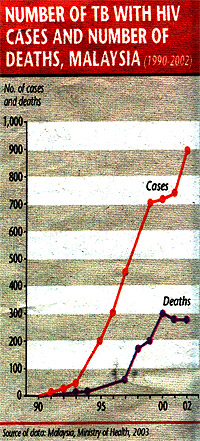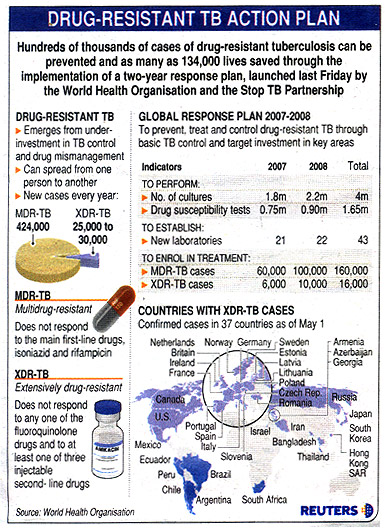Return of an Old Scourge
 The influx of illegal immigrants, late diagnosis and lack of funding to raise awareness of the disease are among the reasons that have seen TB become the No 1 killer infectious disease in Malaysia again, writes TAN CHOE CHOE The influx of illegal immigrants, late diagnosis and lack of funding to raise awareness of the disease are among the reasons that have seen TB become the No 1 killer infectious disease in Malaysia again, writes TAN CHOE CHOE
THE battle with tuberculosis (TB) has raged on for more than 60 years, when the illness killed dozens of people in the then Malaya in the 1940s.
But statistics from the Health Ministry today tells an alarming story of the tenacity of TB. Everyday, it infects 45 people and kills four.
This is despite the aggressive National TB control programme implemented in the early 1960s.
Many of us bear the physical marks of our nation's on-going struggle against the deadly and highly infectious disease.
Rub your upper left arm (or your right if you're a leftie). That little reddish protrusion or scar is from the Bacillus Calmette-Guerin (BCG) vaccine jab in Primary 5 or 6, if not earlier.
BCG vaccination provides protection to children from TB, and is given free at all government hospitals and health clinics for everyone under the age of 20.
However, experts today say that the efficacy of the vaccination is limited for adults.
Just last year, 16,665 new infections were registered, and 1,500 patients died. Within the Asia-Pacific region, 100 people are infected with TB every hour, and in that same time, 35 people die from it, according to the World Health Organisation.
 |
Datuk Seri Yeop Jr Adlan |
"After the TB control programme was put into place in the 1960s, TB was reduced to a manageable level," says Malaysian Association for the Prevention of Tuberculosis (MAPTB) president, Datuk Seri Yeop Jr Yeop Adlan.
Many cases were successfully treated when patients were isolated in sanatoriums set up throughout the country.
Malaysia even had its own TB hospital, the Lady Templer Hospital in Cheras (it was later converted into a private hospital when the disease died down).
"But in the 1980s, TB made a comeback and now, it’s our top (infectious disease) killer again."
Since 2000, the number of Malaysians infected with TB has been steadily rising. The national average of TB infection now stands at 15,000 annually, with a fatality rate of between 1,000 and 1,200 people each year.
Despite the high number of fatalities yearly, there has been little or no report of it in the media until recently.
 "Bird flu has killed fewer than 200 people and yet so much publicity is given to this disease," says Consumers Association of Penang president S.M. Mohamed
ldris. "Similar urgent attention should be given to tuberculosis." "Bird flu has killed fewer than 200 people and yet so much publicity is given to this disease," says Consumers Association of Penang president S.M. Mohamed
ldris. "Similar urgent attention should be given to tuberculosis."
The rate of infection has risen 90 much in recent years that a 2007 World Health Organisation report listed Malaysia at the “intermediate" prevalence level for TB, from the previously "low-medium prevalence" ranking last year.
The migration of people from Indonesia, Myanmar and the Phillippines is largely to blame, says Yeop.
"If we look at the reported infections, we can see that the states with the highest number of cases are also those with high number of foreign workers."
He cites Johor, Seiangor, Kuala Lumpur, Sabah and Sarawak as examples.
The Foreign Worker's Medical Examination Monitoring Agency helps weed out any sickly foreign workers that enter the country each year.
But the question looms — how about illegal immigrants?
"They come in unchecked and many bring with them a range of infectious diseases and spread it to others.”
Aggravating the problem is the ignorance of the public, especially in the rural areas.
"Even when they recognise it, they sometimes think it is santau (black magic curse which is believed to induce similar symptoms) and they are more inclined to see a bomoh for a cure rather than consult a medical doctor."
And when they eventually see a doctor, it is usually too late.
The rise of HIV infection in the country is also seen as a direct contribution to TB infection and deaths.
"With lowered immune system, HIV patients are more likely to get infected and when TB attacks, their immune system is further ravaged, accelerating their deterioration to AIDS."
The emergence of an increasing numbers of Multi-Drug Resistance (MDR) TB patients is also worrying authorities.
This resistance occurs when patients stop taking their medication after one or two months, thinking they have been cured.
"When they suffer a relapse later, they will not respond to the same medication that they were taking before.
It is imperative that a TB patient follows strictly the medication regime prescribed by his doctor.
"If you stop going to the hospital for monitoring and treatment, it will be doubly hard to recover."
WHO has introduced the Directly Observed Treatment Short Course (Dots) strategy, which emphasises the supervision of patients throughout the course of his treatment.
It has shown almost a 100 per cent success rate in countries where it was implemented effectively.
"The supervision can be done by a family member, a member of the community, or a trained medical staff.
"Their duty is to check that the patient takes his medicine accordingly and tick it on a checklist and signs it for verification."
Money Matters |
WHAT can RM20 do for you in a month? Definitely not much these days. But this is the average amount given by Malaysian Association for the Prevention of Tuberculosis (MAPTB) under its Treatment Allowance Scheme to aid low-income TB patients.
The amount has not changed since the scheme started in the 1960s.
"In the earlier days, we were permitted to run a social welfare lottery to fund this scheme and other activities," says Yeop.
But the permit for the lottery was revoked when the government started giving out grants to the MAPTB.
With an average 15,000 TB patients yearly, the association gets a grant of some RM450,000 from the Health Ministry, which Yeop says "isn't enough".
"It averages out to about RM20 per person."
Ideally, he says each deserving TB patient should be given an allowance of RM400. |

• MAPTB is a non-governmental organisation set up in 1948 to supplement the government's efforts to combat TB. It will be hosting the first Asia Pacific Region
Conference for the International Union Against Tuberculosis and Lung Disease on Aug 2-5. For information, call 03-21620566. |

